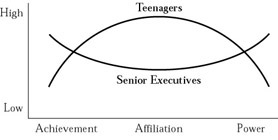Chapter 3: Joining a Company
Overview
On the surface, this passage—the first we describe—may appear to be relatively simple when you first embark on it. After all, you join a company because the company wants you. Your new organization welcomes you with open arms. There is a deceptive sense of smooth sailing, but if you’re not prepared for the storms ahead, you will be sunk.
It helps to remember that this passage is a transition and, as with all transitions, a gap exists between appearance and reality. Or to put it more bluntly, what you see is often not what you get. This is true for recent graduates and even more so for veteran executives. According to research done many years ago by Harvard psychologist David McClelland, individuals are motivated by needs for achievement, power, and affiliation that vary throughout the life cycle. For example, teenagers are often motivated by their need for acceptance by their peers—a strong need for affiliation that carries over into college and first jobs. Younger people entering a corporation for the first time are motivated by a need to belong, to be included, to be on the team. They want to fit in with a company and a culture. After a while, these new recruits begin to establish a professional reputation and to focus on achieving career goals. Eventually, after being promoted, a need for power and impact comes into play. See Figure 3.1 for a “motive profile.”

Figure 3.1: Motive Profile.
Source: Bridges, 1980.
Joining a company at the outset of a career can sometimes result in disappointment when young people discover that their values don’t match those of their new companies and they must compromise or leave. People joining new companies at midcareer may be similarly frustrated to discover that, despite promised opportunities for achievement or promotion, not everyone is eager to have them on board; they sometimes encounter resistance or outright hostility from employees who resent that an outsider was hired, perhaps for a job they thought was rightfully theirs.
Even more problematic for veteran executives is their attitude; they join companies brimming with confidence and certainty that they know exactly what to do. As we’ve discussed, their previous success frequently makes them closed to new learning. As a result, top people join companies believing they have been hired to make change, improve performance, and rewrite history, and conclude that they must know everything necessary to succeed. And then they fail.
Like every passage, joining a company contains formidable obstacles, as well as tremendous opportunities for leadership learning and growth. To take advantage of these opportunities, you need to understand why this passage can turn dark and difficult in a matter of weeks or months.
EAN: 2147483647
Pages: 121